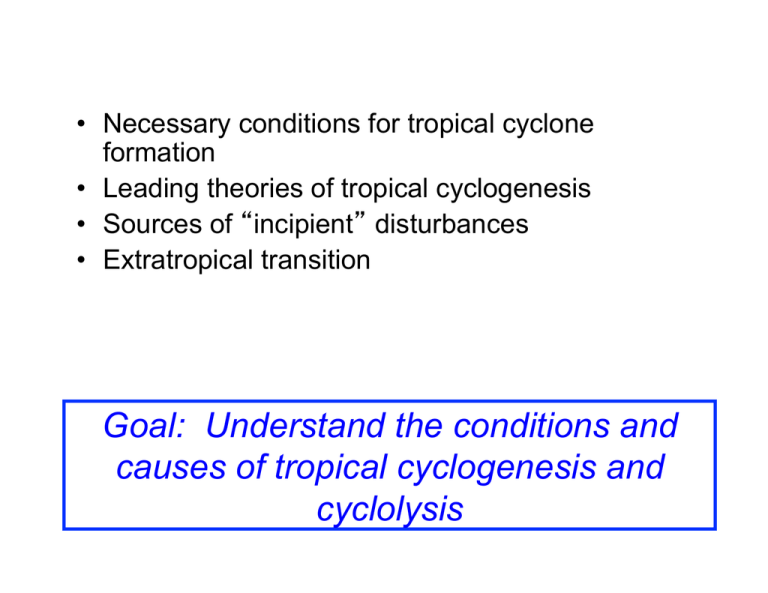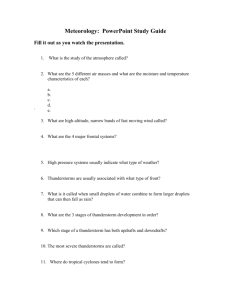Goal: Understand the conditions and causes of tropical cyclogenesis
advertisement

• Necessary conditions for tropical cyclone formation • Leading theories of tropical cyclogenesis • Sources of incipient disturbances • Extratropical transition Goal: Understand the conditions and causes of tropical cyclogenesis and cyclolysis Conditions required for tropical cyclogenesis • Latitudes poleward of ~5° • Adequate ocean thermal energy – SST>26° extending to a depth of 60m • Moist troposphere • Enhanced lower troposphere relative vorticity • Weak vertical shear Rossby radius of deformation The Rossby radius of deformation, LR, defines the scale at which rotation becomes comparable to the buoyancy force: LR = NH "+ f ! • LR is a measure of the distance traveled by gravity waves in an inertial period • Perturbations (e.g., a diabatic heating anomaly) smaller than LR are simply dissipated via gravity waves • Features larger than LR are governed by Rossby wave dynamics • One can also think of LR in terms of partitioning between (potential) vorticity and static stability or potential and kinetic energies –e.g., the adjusted state of a large scale disturbance reflects in temperature/height, thus appears in the mass field (potential energy) Theories of tropical cyclogenesis • Conditional instability of the 2nd Kind (CISK) • Wind-induced surface heat exchange (WISHE)* *Essentially the Carnot framework. Overview of CISK • Prior: Miller’s model (1958) – Maximum intensity related to storm center SST, surface relative humidity, environmental lapse rate, and top-of-the-storm potential temperature and height • CISK proposed in the 1960s [Charney and Eliassen, 1964] consistent with the Miller model – The motivating question was: How do cyclones form when the tropical environment appears to favor small-scale convection? • The basic idea underlying CISK is cooperation between small scale convection and the larger-scale circulation (positive feedback) – Frictional convergence of high ABL θe (warm & moist) air produces vertical motion (Ekman pumping) [Note: friction decelerates surface winds, which causes the low level convergence] – In the vertical ascent region, release of latent heat occurs that drives a secondary circulation that increases inflow – Also, vertical vortex stretching increases surface cyclonic motion (vorticity), leading to more Ekman pumping • When latent heat release balances surface frictional dissipation, cyclone maintains its intensity CISK Schematic WISHE • In the lecture on convective QE, we discussed issues that argue against CISK – In particular, CISK requires widespread conditional instability, although the tropical atmosphere is observed to be close to neutral stability • Emanuel et al. 1994 outlined the argument for WISHE-induced tropical cyclogenesis – An incipient disturbance generates vertical motion that leads to downdrafts of low θe air – However, stratiform precipitation moistens the subcloud layer, which offsets the low θe air – Latent heating from the wind-induced evaporation dominates, heating the core and allowing the vortex to grow • Thus, WISHE creates instability through energy extraction from the underlying ocean WISHE Schematic Core dynamics: mesoscale vortices http://cimss.ssec.wisc.edu/tropic/Isabel_Ancillary/ Eyewall replacement cycles • Concentric eyewalls may be observed during periods of strengthening or weakening of intense tropical cyclones • Eyewalls contract as the tropical cyclone intensify. If an outer eyewall begins to form, moisture and momentum are extracted from the existing eyewall, leading to dissipation of the inner eyewall • The outer eyewall then intensifies and contracts • Eyewall replacement cycles may last 12-18 hours to several days Hurricane Ivan double eyewalls Sources of incipient disturbances • Recall the first step in tropical cyclone development is a tropical disturbance. What are the sources of such disturbances? • Mechanisms: – Monsoon trough – ITCZ breakdown – Equatorial waves [Rossby, mixed Rossby-gravity] – Easterly waves – Mesoscale convective complexes – Subtropical storms • Note that not all incipient disturbances in regions of favorable conditions develop into tropical cyclones: e.g., ~100 disturbances per hurricane season in the Atlantic, of which ~15 become tropical cyclones Monsoon trough Summary of mechanisms of disturbance generation associated with the monsoon trough Monsoon trough mechanisms • Tropical Upper Troposphere Trough (TUTT): meso- to synoptic-scale upper tropospheric cold low – Interactions of easterly waves with the TUTT may enhance lowlevel convergence, leading to favorable conditions for cyclogenesis. • Monsoon gyre: closed, symmetric circulation at ~850 mb extending over ~25° latitude • ITCZ or monson trough breakdown: convection within the ITCZ leads to destabilization and breakdown via both barotropic and baroclinic instability – Breakdown may form groups of tropical cyclones or a single large one Equatorial Rossby wave pair Mixed Rossby-gravity wave African Easterly Waves (AEWs) • Easterly waves that form over the African continent during the monsoon season may initiate cyclones over both the Atlantic and Pacific – ~60% of Atlantic hurricanes, and ~85% of major hurricanes, develop from AEWs • These waves form as a result of instability in the African Easterly Jet. • They have periods of roughly 3-5 days, have spatial scales of ~1000 km, and move at speeds of 7-8 ms-1. • MCSs embedded within the AEWs may provide additional voriticity for initiating tropical cyclones. African Easterly Waves (AEW) African Easterly Wave Hurricane Oliver (1993): Formation from merger of 2 MCSs a. Initial cluster of weak mesoscale vortices b. Two MSCs develop from these vortices c. The MCS on the right in b. develops an eye-like feature d. This strengthened MCS shears the other, which becomes a spiral rainband The above occurred in the process of the large-scale monsoon trough environment developing enhanced low-level vorticity, decreasing the local Rossby radius of deformation Factors limiting tropical cyclone development Essentially, conditions opposite to the necessary conditions for tropical cyclogenesis: • Inadequate ocean thermal energy • Dry troposphere • Diminished lower troposphere relative vorticity • Strong vertical shear • Also: Landfall Saharan Air Layer Extratropical Transition • Tropical cyclones entering midlatitudes encounter conditions unfavorable to their maintenance which lead to decay: however, extratropical transition is the process by which tropical cyclones become extratropical in nature • Although they may weaken prior to transition [as they experience recurvature, namely a change in direction from westwardpoleward to eastward-poleward], transitioning systems can reintensify • The transitioning system can also provide thermal contrasts for subsequent midlatitude cyclogenesis; the energetics can also interact with the pattern of midlatitude planetary waves, thereby exciting cyclogenesis remote from the transitioning system • The likelihood of extratropical transition depends on the structure and intensity of the tropical cyclone, its thermodynamic environment, and the characteristics of the midlatitude trough Extratropical transition of Typhoon Tokage


